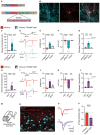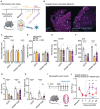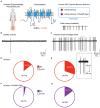A humanized chemogenetic system inhibits murine pain-related behavior and hyperactivity in human sensory neurons
- PMID: 37792955
- PMCID: PMC7615191
- DOI: 10.1126/scitranslmed.adh3839
A humanized chemogenetic system inhibits murine pain-related behavior and hyperactivity in human sensory neurons
Abstract
Hyperexcitability in sensory neurons is known to underlie many of the maladaptive changes associated with persistent pain. Chemogenetics has shown promise as a means to suppress such excitability, yet chemogenetic approaches suitable for human applications are needed. PSAM4-GlyR is a modular system based on the human α7 nicotinic acetylcholine and glycine receptors, which responds to inert chemical ligands and the clinically approved drug varenicline. Here, we demonstrated the efficacy of this channel in silencing both mouse and human sensory neurons by the activation of large shunting conductances after agonist administration. Virally mediated expression of PSAM4-GlyR in mouse sensory neurons produced behavioral hyposensitivity upon agonist administration, which was recovered upon agonist washout. Stable expression of the channel led to similar reversible suppression of pain-related behavior even after 10 months of viral delivery. Mechanical and spontaneous pain readouts were also ameliorated by PSAM4-GlyR activation in acute and joint pain inflammation mouse models. Furthermore, suppression of mechanical hypersensitivity generated by a spared nerve injury model of neuropathic pain was also observed upon activation of the channel. Effective silencing of behavioral hypersensitivity was reproduced in a human model of hyperexcitability and clinical pain: PSAM4-GlyR activation decreased the excitability of human-induced pluripotent stem cell-derived sensory neurons and spontaneous activity due to a gain-of-function NaV1.7 mutation causing inherited erythromelalgia. Our results demonstrate the contribution of sensory neuron hyperexcitability to neuropathic pain and the translational potential of an effective, stable, and reversible humanized chemogenetic system for the treatment of pain.
Conflict of interest statement
D.L.B. has acted as a consultant on behalf of Oxford Innovation for Abide, Amgen, Combigene, G Mitsubishi, Lilly, Tanabe, GSK, TEVA, Biogen, Lilly, Orion, Third Rock and Theranexus.
Figures






Comment in
-
Pain management by chemogenetic control of sensory neurons.Cell Rep Med. 2023 Dec 19;4(12):101338. doi: 10.1016/j.xcrm.2023.101338. Cell Rep Med. 2023. PMID: 38118411 Free PMC article.
References
-
- Breivik H, Collett B, Ventafridda V, Cohen R, Gallacher D. Survey of chronic pain in Europe: prevalence, impact on daily life, and treatment. Eur J Pain. 2006;10:287–333. - PubMed
-
- Walsh DA, McWilliams DF. Mechanisms, impact and management of pain in rheumatoid arthritis. Nat Rev Rheumatol. 2014;10:581–592. - PubMed
Publication types
MeSH terms
Grants and funding
- MR/W002388/1/MRC_/Medical Research Council/United Kingdom
- 202747/WT_/Wellcome Trust/United Kingdom
- 109116/WT_/Wellcome Trust/United Kingdom
- 202747/Z/16/Z/WT_/Wellcome Trust/United Kingdom
- 109116/Z/15/Z/WT_/Wellcome Trust/United Kingdom
- 102645/Z/13/Z/WT_/Wellcome Trust/United Kingdom
- MR/T020113/1/MRC_/Medical Research Council/United Kingdom
- MR/W002426/1/MRC_/Medical Research Council/United Kingdom
- 102645/WT_/Wellcome Trust/United Kingdom
- 223149/Z/21/Z/WT_/Wellcome Trust/United Kingdom
- 223149/WT_/Wellcome Trust/United Kingdom
- BB/V509528/1/BB_/Biotechnology and Biological Sciences Research Council/United Kingdom
LinkOut - more resources
Full Text Sources
Research Materials

